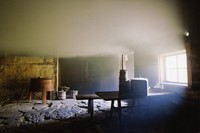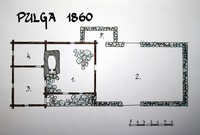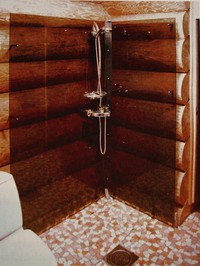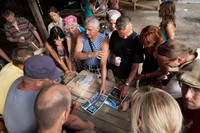Laht Marike (Tallinn, Estonia)
New possibilities and traditional skills
 @kizhi
@kizhi








Summary: The article presents acitivites of the Estonian Open Air Museum (Tallinn, Estonia) in preservation of the traditional culture. It is shown that the museum not only represents the collection of the best examples of rural architecture, but also keeps traditional skills and technologies. The outcomes of the EU projects, held by the museum – “Healthy and Energy-Efficient Living in Traditional Rural Houses“ (HELTH, 2010-2012) and “Fungi and Beetles in Buildings on Islands of the Baltic Sea“ (FaBBi, 2010-2013) enabled improving the knowledges in conservation of traditional houses and finding the solution for their adaptation to modern living standards. It is highlighted that the Estonian Open Air Museum pays the leading role in training of private owners how to renovate and maintain their houses and how to find energy-saving solutions for old buildings.
Keywords: development plans; projects; training courses for the house-owners;
Аннотация: В статье представлена деятельность Эстонского музея под открытым небом (Таллинн, Эстония), по сохранению традиционной культуры. Показано, что музей не только представляет в своей коллекции лучшие образцы сельской архитектуры, но и хранит традиционное мастерство и технологии. Результаты проектов Европейского союза, осуществленных музеем, - «Здоровая и энергетически эффективная жизнь в традиционных сельских домах» (HELTH, 2010-2012) и «Грибы и насекомые в домах на островах Балтийского моря» (FaBBi, 2010-2013) позволили получить новые знания по консервации традиционных домов и найти решения для их адаптации к современным стандартам жизни. Подчеркивается, что Эстонский музей под открытым небом играет ведущую роль в обучении владельцев частных домов методам восстановления и обслуживания домов, а также поиску энергосберегающих решений для старых зданий.
Ключевые слова: планы развития; проекты; обучающие курсы для домовладельцев;
Новые возможности и традиционное мастерство
New trends
It certainly has to be agreed that everything new is actually a freshly discovered and re-evaluated old. Already in the 1960s the successful building-up of the open air museum and the specialists’ interest in gathering the best examples of rural architecture to the museum had laid the foundation to the dissemination of heritage protection ideas all over Estonia. The beginning of the 21st century saw the situation where society became aware of the necessity to pay more attention to the preservation of rural architecture. During the extensive growth of Soviet-time collective farms, farmstead in the countryside had become derelict, and now both the descendants of former owners as well as other people keen on country life became interested in restoring them. It was the latter – the so-called romantics – who, fleeing from the hubbub of city life, were eager to found life in their new homes as much as possible on the old and the valuable [1] (Fig. 1).
The Estonian Open Air Museum, which is situated at the distance of a ten-minutes’ drive from the centre of Tallinn, on Kakumäe Peninsula, on the coast of Kopli Bay, has been aiming at offering its visitors this kind of idyllic experience for the past fifty-eight years – or, to be more exact, for the past twenty five years, because in its initial years the museum concept was all about the highly scientific presentation of the architectural collection and ancient living conditions, with strict restrictions concerning the diversification of the exposition and its mediation to the public (Fig. 2).
While in the 1980s people were still striving for moving from the countryside to towns, because of better job and living opportunities and more exciting life, then beginning from the 1990s the tendency has been quite the opposite. Now people are aiming at getting away from town and not only just to the countryside but namely into the buildings that date from 100-150 years back. When the decision has been made to go back to one’s roots, it brings along a great number of problems that need solutions. And then it is the museum, the place for knowledge and advices [2] .
And so the museum – or, to be more exact – the museum conservators come to rescue, because in the course of time they have gathered sufficient expertise and skills for solving these problems. It happens quite often in Estonia that buildings are deserted and just remain derelict. Reasons for that can be different, yet the consequences are usually the same – wood-damaging pests infest buildings and when the roof happens to leak, there is no way to escape fungi, either [3] .[текст с сайта музея-заповедника "Кижи": http://kizhi.karelia.ru]
The exposition of the Estonian Open Air Museum, which is situated on seventy eight hectares and comprises seventy-six objects, is a good example demonstrating what can happen when buildings are not used for their initial purposes any more but they are just left standing on their own. For decades scientists have resorted to chemicals, but the ones that eradicate fungi and beetles, usually tend to damage people’s health. Throughout 1960s-1980s NaPClF (sodium pentachlorophenol) solutions in different concentrations were widely used. Today we can clearly detect traces of this processing on log walls, which mainly present themselves in the form of crystallized chemicals on the surface and the darkened colour characteristic of wood. Last twenty years have been given to us in museum possibilities to use building during the year [4] .
Rural architecture and rural landscape
The frequently asked questions and people’s gradually increasing endeavours to do something about their country homes gave an impetus to a project-based programme at the Estonian Open Air Museum in 2007, consisting in inventorying and registering all the preserved barn dwellings – the buildings inherent in Estonian farm architecture - which are still in use. It is a public programme entitled “Rural Architecture and Rural Landscape. Studies and Maintenance”. With this programme the museum has crossed the borders of ordinary museum work and has started to support the vitality of Estonian heritage landscapes and the continuity of their usage, hereby also achieving the level of international cooperation [5] .
Estonians’ barn dwelling is a unique structure, as it gathers under one roof all the constituents necessary for life and for obtaining the main subsistence – bread. Summers in Estonia are rather short and often also rainy, so it was not infrequent that grain did not ripen in the field. The barn dwelling, which by its nature was, above all, a winter dwelling, was initially divided into a heated threshing room, a threshing floor and a cold chamber; in the course of time clean living chambers were added. The most important room in the barn dwelling was the threshing room, where in early autumn bread corn was dried on poles in the heat of the barn kiln. The big flueless or keris stove in the corner was heated and the corn on the poles ripened further in the heat and smoke. This was highly appreciated at that time as the bread corn that was dried and smoked this way did not mould that easily and due to the smoke grain acquired a peculiar flavour. In the adjacent threshing floor the rye grain was flailed and after that winnowed at the opened doors of the threshing floor. In wintertime domestic animals were often brought into the threshing floor, where it was easier to tend them. As was mentioned before, in the course of time clean chambers with wooden floors were added on the other side of the threshing room. Initially, the threshing room served as a living, dining and bedroom for the household in wintertime [6] (Fig. 3, 4).
Projects
The buildings made of thick logs with moss stuffed in the gaps between them have served as homes for Estonians for centuries already and as such deserve recording as our cultural heritage. The owners of the barn dwellings that were inventoried within the programme have now the opportunity to find solutions to their problems more easily and this way a great number of people have assembled round the museum, who have started to restore their ancestors’ farmsteads in the countryside or have decided to purchase dilapidating heritage buildings. It also helps if you are aware that there are other people out there who also have barn dwellings in their possession and who face the same problems as you. In our nostalgic visions we would sometimes crave for the faraway time when houses did not have chimneys and smoke was let out after heating through special holes in the wall; yet, we would not object modern conveniences, either. In order to combine these possibilities and find the best solutions without damaging the initial building or changing it as little and as delicately as possible, a project entitled „Healthy and Energy-Efficient Living in Traditional Rural Houses“ (HELTH, for short) was launched on the initiative of the Estonian Open Air Museum in 2010. The pronunciation is similar to the word ‘health’ and this is actually also the meaning behind it. Besides the Open Air Museum, also Tallinn Technical University, Aalto University in Helsinki and Gotland University participate in the project. In order to achieve the objectives, the activities in the project have been divided into two parts: fieldwork and studies and educational counselling. Within the project moisture and temperature oscillation is investigated, as well as damage caused by this in the buildings that are heatable both periodically and all the year round, and also hydrothermal impact, including risk growth of decaying due to vapour condensing. In Estonia the aforementioned buildings are barn dwellings, in Gotland it is stone buildings that are under observation, and in Finland it is frame houses that are investigated. The owners of old buildings are taught how to renovate with the correct materials, how to adapt heaters to modern requirements and keep them in operation, how to find energy-saving solutions for old buildings, and so on. The total budget of the project is 1 007 331 euros and its duration is from 2010 to 2012.
At the end of 2010 another project of INTERREG IVA Central Baltic programme was added, entitled „Fungi and Beetles in Buildings on Islands of the Baltic Sea“ (FaBBi for short), with the total budget of 1.195 million euros. The museum was the leader partner in this one as well and cooperates with the Estonian University of Life Sciences, the Estonian Mycology Research Centre and Gotland University. The aim of this project was to study biological damage caused by beetles and fungi on West-Estonian islands. Within the project expeditions were organized to different regions with the aim to estimate the current technical condition of architectural objects. Various courses and study days were organized for local authorities, construction entrepreneurs and house-owners to teach them how to manage biological damage. Also, a manual and informative materials was drawn up describing the main damaging factors and providing guidelines for action in certain situations, when a biological damager has been detected. In the course of fieldwork three twenty-minute study films was made about beetle damage, fungi damage and processing and conditions to avoid all possible biological damagers. A great number of foreign experts and specialists from Germany, Russia, Latvia, Holland, Sweden, Denmark and Finland had been involved in the project activities. The greatest challenge was to elaborate a new methodology and technology, which should be able to prevent beetle damage. The duration of this project was from 2011 to 2013.
New challenges
By its nature open-air museums are not only collections of buildings, but also reflect the skills and way of life characteristic of the era. The conveyance of different skills largely depends on conservators, because each exhibit in need of repair requires understanding and perception of how and why it was made in its time. So the Estonian Open Air Museums has started to spread the gathered knowledge to those interested through workshops and different trainings. We teach people how to hew logs, make a shingle or a thatched roof, build traditional wooden or stone fences, and so on [7] (Fig. 5).
At the same time the aforementioned projects also enable the museum to keep its own problems under control. Currently there are seven buildings at the museum, which are open to the visitors all the year round. While in the case of Kolu Inn and the schoolhouse no question arises about why it is good or necessary, then in the case of the other three buildings it is because this way it is possible for us to keep the thermal and moisture regimes of the buildings stable and eliminate all possible damage in its early development (Fig. 6). Today two new farmyards with four buildings have been constructed at the museum, they are open for the visitors now , and here we also take into account the data resulting from the project and use the best and most energy-efficient solutions suggested by our university partners. So we apply modern solutions, which guarantee the stability of the required thermal and moisture regimes and enable the museum to keep under more efficient control the general costs and expenditures related to preservation. On the one hand, this kind of expanded possibilities facilitate the conservators’ work; however, on the other, they add new requirements in strictly professional issues but also on a wider scale. It means that besides the knowledge of requirements or best conditions for the preservation of exhibits we also have to consider the damage that might occur due to the co-influence of the new possibilities (Fig. 7). During the past decades a great problem has occurred in the vicinity of the museum on Kakumäe Peninsula with a raised bog in the middle – it is active real estate development, in the course of which historic landforms have changed and water from the bog seeks to flow out, flooding the museum territory for a great part of the year and causing serious problems of excessive moisture. The house-owners have often the same kind problems, so the courses and practical training how to solve the problems are very welcome (Fig. 8). [текст с сайта музея-заповедника "Кижи": http://kizhi.karelia.ru]
Conclusion
What to say? Times have changed and so the conservators of the Estonian Open Air Museum have to acquaint themselves with the new opportunities that come up; yet, an objective estimation of these opportunities is not always a simple task. Decision-making is certainly facilitated by considering the results of the investigations conducted within the projects and involving experts. This way it is possible to find the best and most constructive solutions for the rising problems as changed times cannot be an excuse for making mistakes or wrong choices and most important step by step success will forward all of us.
- [1] Laht Marike, 2011, Bucharest „Dimitrie Gusti“ National Village Museum, plenary lecture 02.11.2011 Museum come to rescue! New challenges and courses of action for the conservators of the Estonian Open Air Museum
- [2] Stroh Lea Täheväli, 2005 Kodukiri, Maja ja niiskus. Tallinn
- [3] Konsa Kurmo, Pilt Kalle, 2012 AS Atlex , Hoonete Biokahjustused. Tartu
- [4] Laht M., 2011
- [5] Pärdi Heiki, Lutsepp Elo, Tamjärv Maret, 2008 Eesti Vabaõhumuuseumi Toimetised I. Rural architecture and rural landscape. p. 10-11; Tallinn
- [6] Pärdi et. Al., p. 51-88
- [7] Klõšeiko Paul, Arumägi Endrik, Kalamees Targo, 2013 OÜ Meediapilt, Ökomäss. Artiklid. Nõuanded. p.22-23,
Текст может отличаться от опубликованного в печатном издании, что обусловлено особенностями подготовки текстов для интернет-сайта.
